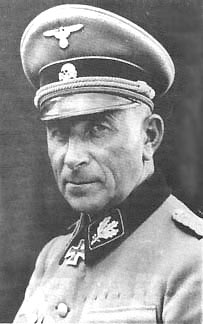
SS-Obergruppenf�hrer und General der Waffen-SS
Paul Hausser

 Born: October 7th, 1880 in Brandenburg
Born: October 7th, 1880 in BrandenburgDied: December 21st, 1972 in Ludwigsburg Iron Cross 2nd Class: World War One Iron Cross 1st Class: World War One Knights Cross: August 8th, 1941 Oakleaves:July 28th, 1943 Swords: August 26th, 1944 Paul Hausser served with the Kaiser's army in the First World War and was decorated for action during this conflict. In the inter-war years, Hausser served with various units from 1920-1932, reaching the rank of Generalleutnant. After retiring from the Army, he was part of the Stahlhelm, which was later absorbed by the SA. Hausser served as an SA-Standartenfuhrer. In November, 1934, Hausser transfered to the SS-Verfugungstruppe and was assigned to SS-Fuhrerschule Braunschweig. In 1935 he became Inspector of SS-Junkerschule and was promoted to SS-Brigadefuhrer in 1936. Hausser served in Poland as an observer with the mixed Army/SS Panzer Division "Kempf". In October, 1939 SS-VT was formed as a division with Hausser in command. He led the division through the battles in the west and during Barbarossa. During his command of "Reich" in Russia, Hausser was awarded the KC and was severly wounded, losing an eye. After recovering he commanded II. SS-Panzer Korps and disobeyed Hitler's orders and withdrew his troops from Kharkov avoid encirclement. Later Hausser recaptured the city in March 1943 with his Korps. He led Das Reich, Leibstandarte SS Adolf Hitler and Totenkopf during Kursk. After Kursk Hausser (and his Korps-now composed of 9th and 10th SS Pz. Divs.) were stationed on the Western front until he was promoted to commander of 7. Armee. During the Falaise encirclement, Hausser remained with his troops ensuring that as many men could escape the Allied pincers as possible. Hausser ended the war on Feldmarschal Albert Kesselring's staff. |